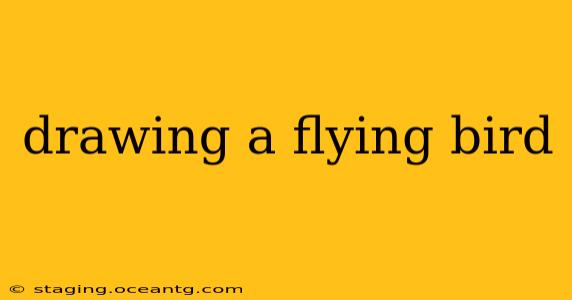Drawing a bird in flight can seem daunting, but with a structured approach and understanding of basic avian anatomy, it becomes a rewarding and achievable task. This guide will break down the process, from initial sketching to adding final details, catering to both beginners and those looking to refine their skills.
What are the Basic Shapes of a Bird in Flight?
Before diving into intricate details, simplify the bird's form. Think of its body as a series of interconnected shapes: an elongated oval or teardrop for the body, slightly curved lines for the wings, and a small triangle or circle for the head. This foundational approach helps you establish the bird's posture and movement before adding finer details. Understanding these basic shapes is crucial for accurately capturing the dynamics of flight.
How Do I Draw the Wings of a Flying Bird?
Bird wings are complex, but breaking them down into simpler components makes them easier to draw. Observe the primary and secondary feathers – the longer primaries extend from the "hand" and create the wingtip's shape, while the shorter secondaries fill the area closer to the body. Pay attention to how these feathers overlap and curve, creating a three-dimensional effect. Don't be afraid to simplify the individual feathers – suggesting their shape and movement is more important than rendering each one in detail, especially when starting out. Remember that the wing's shape and position significantly impact the bird's overall posture and the feeling of motion.
What About the Bird's Body and Head?
While the wings are prominent, the body and head contribute significantly to the bird's overall appearance and believability. The body is generally streamlined, following the teardrop shape mentioned earlier, adjusting according to the bird's species and posture in flight. The head should be proportionally sized to the body and positioned in a way that complements the bird's overall movement – a tilted head can suggest alertness or curiosity, while a straight head might indicate focused flight. Pay attention to subtle details like the beak and eye, adding personality and realism to your drawing.
How Do I Draw the Feet of a Bird in Flight?
Often overlooked, the bird's feet play a subtle yet important role in portraying flight. They are typically tucked neatly against the body, usually barely visible beneath the feathers. Including them, even subtly, adds to the realism and completeness of your drawing. Their position can also subtly imply the bird's posture and the stage of its flight.
How Can I Add Movement and Dynamism to My Drawing?
Adding dynamism is key to depicting the feeling of flight. Use flowing lines to suggest air movement, feather movement, and the overall motion of the bird. Pay close attention to the angles of the wings and body – a slightly tilted body suggests a turn or a change in direction. Emphasize the curvature of the flight path by using subtle indications of motion blur, especially around the wings.
What Materials Should I Use?
Experiment with different media! Pencils offer versatility for sketching and shading. Charcoal provides a rich, dramatic effect, especially for capturing the texture of feathers. Pens allow for clean, precise lines. Watercolors or acrylics can add beautiful color and texture once you're comfortable with the basic form. Find the materials that best suit your style and preferences.
People Also Ask:
How do I draw realistic bird feathers?
Don't aim for perfect feather detail at first. Focus on suggesting the texture and direction of the feathers by using varied lines and shading to mimic their overlapping structure. Close observation of real bird feathers or reference photos will help you understand their subtle variations.
What is the best way to practice drawing birds in flight?
Consistent practice is key. Begin with simple shapes, gradually adding detail as your confidence grows. Use reference photos or videos to study bird movements and postures. Break down the process into manageable steps, focusing on one aspect at a time (wings, body, head).
How do I draw different types of birds in flight?
Different birds have unique body shapes and flight styles. Observing real birds or high-quality reference images is essential. Note the variations in wing shapes, body proportions, and flight patterns.
Where can I find good reference images for drawing birds in flight?
Numerous online resources offer high-quality images and videos of birds in flight. Look for reputable wildlife photography websites and nature documentaries. Even observing birds in your local area can provide invaluable insights.
By following these steps and dedicating time to practice, you'll improve your ability to capture the grace and dynamism of birds in flight. Remember, patience and consistent effort are key to mastering this challenging yet rewarding art form.
